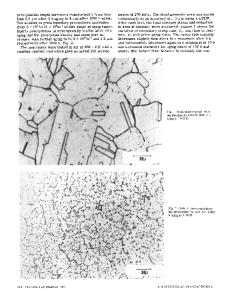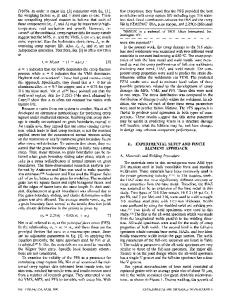Effect of antimony on the creep fracture of stainless steel
- PDF / 1,259,920 Bytes
- 7 Pages / 613 x 788.28 pts Page_size
- 8 Downloads / 296 Views
J. SOULLARD, L. MARTINEZ, and J. H. SCHNEIBEL Stainless steel samples doped with various contents of Sb were crept under the same conditions. With respect to the base material, a low content of Sb (0.1 wt pct or 0.2 wt pct) is found to improve creep strength and creep ductility of the alloys whereas the addition of 1 wt pct Sb decreases the mechanical properties. The microstructure of the samples was examined quantitatively by scanning electron microscopy. The improvement of mechanical properties is attributed to a reduction of the nucleation rate and of the growth rate of cavities. In order to predict the strain to fracture, a criterion on the fraction of grain boundary area cavitated is proposed.
I.
INTRODUCTION
THEeffects of impurities on grain boundary properties are intensively studied because they are related to important technological problems like fracture. Segregation of impurities to grain boundaries is known to modify the kinetics of cavity growth and cavity nucleation, these two processes being responsible for intergranular fracture of metals and alloys under creep conditions.l'2'3 Among the first studies dealing with the improvement of mechanical properties of alloys by impurity addition, those related to the effect of B in austenitic steels 4 and Ni-base alloys5 are found. More recently, the addition of 0.11 pct Zr was found to improve creep strength and ductility of Ni + 20 pct Cr. 6'7 This improvement is attributed to a decrease in the growth and nucleation rates of cavities which results partly from a slowing down of the grain boundary diffusivity which can be attributed to a delay of S segregation resulting from intergranular precipitation of sulfides. Strength and ductility are also increased by addition of Zr and B to a Ni-base alloy similar to the previous one.8 In that case the effect is also attributed to a delay in S segregation but, in addition, the particles which form at the grain boundaries (mainly carbides) are found to be more closely spaced in the doped alloy than in the undoped material, reducing the stress concentration required for cavity nucleation. 9 In that case B makes the grain boundaries less susceptible to cavity nucleation. The previous studies make clear that S has a negative effect on the mechanical properties of Ni-base alloys. This impurity was also shown to cause intergranular embrittlement of austenitic steel l~ and to improve atomic mobility in the grain boundary of this alloy. 12Another unfavorable impurity is Sb. Its embrittlement effect in low alloy steel 13'14is well known and is explained by a weakening of the metal-metal bond at the grain boundary where Sb segregates. As Sb is an electronegative impurity, it draws electrons off the metal atoms around it, and this charge transfer decreases the number of electrons available to participate in the metal-metal bonds. In many cases two impurities act together to modify the mechanical properties of an alloy as B and Zr do in Ni-base alloys, for instance. Another case is the joint effect of S and J. SOULLARD and L.
Data Loading...











